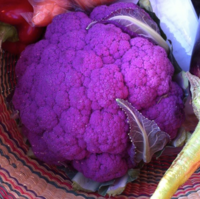
Photo from wikipedia
A study was conducted to identify optimal ultrasound processing conditions (ultrasound energy density and temperature) to maximize the extraction of anthocyanin colorants from black carrot pomace. The treatment maximized the… Click to show full abstract
A study was conducted to identify optimal ultrasound processing conditions (ultrasound energy density and temperature) to maximize the extraction of anthocyanin colorants from black carrot pomace. The treatment maximized the yield of five different anthocyanin compounds from black carrot pomace with cyanidin-3-xyloside-galactoside-glucoside-ferrulic acid (C3XGGF, 60.85-74.22mg/L) as the most abundant anthocyanin compound, followed by cyanidin-3-xyloside-galactoside (C3XG, 49.56-70.12mg/L). The response surface models predicted that if extraction conditions were conducted at 183.1J/g energy density and 50°C, the yield of various anthocyanin compounds would be maximized from the black carrot pomace. Response surface models were developed correlating anthocyanin yield with ultrasonication treatment parameters. The study showed the synergy of combining ultrasonication and temperature for the extraction of anthocyanin pigments from black carrot pomace. Results of the study also further demonstrate the potential of ultrasonication technology as a tool for the extraction of valuable components waste products from fruits and vegetables juice industry.
Journal Title: Food chemistry
Year Published: 2017
Link to full text (if available)
Share on Social Media: Sign Up to like & get
recommendations!